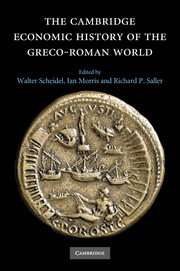Book contents
- Frontmatter
- 1 Introduction
- Part I Determinants of Economic Performance
- Part II Early Mediterranean Economies and the Near East
- Part III Classical Greece
- Part IV The Hellenistic States
- Part V Early Italy and the Roman Republic
- Part VI The Early Roman Empire
- 20 The Early Roman Empire: Production
- 21 The Early Roman Empire: Distribution
- 22 The Early Roman Empire: Consumption
- 23 The Early Roman Empire: The State and the Economy
- Part VII Regional Development in the Roman Empire
- Part VIII Epilogue
- Bibliography
- Index
- Map 1.1 The Mediterranean basin"
- Map 10.1 Greek and Phoenician trade in the period of the Persian Wars"
- Map 11.1 The Achaemenid empire"
- Map 12.1 Greece and Asia Minor"
- Map 15.1 The Seleucid empire"
- Map 16.1 Greco-Roman Egypt"
- Map 20.1 The Roman empire at the accession of Vespasian"
- References
22 - The Early Roman Empire: Consumption
from Part VI - The Early Roman Empire
Published online by Cambridge University Press: 28 March 2008
- Frontmatter
- 1 Introduction
- Part I Determinants of Economic Performance
- Part II Early Mediterranean Economies and the Near East
- Part III Classical Greece
- Part IV The Hellenistic States
- Part V Early Italy and the Roman Republic
- Part VI The Early Roman Empire
- 20 The Early Roman Empire: Production
- 21 The Early Roman Empire: Distribution
- 22 The Early Roman Empire: Consumption
- 23 The Early Roman Empire: The State and the Economy
- Part VII Regional Development in the Roman Empire
- Part VIII Epilogue
- Bibliography
- Index
- Map 1.1 The Mediterranean basin"
- Map 10.1 Greek and Phoenician trade in the period of the Persian Wars"
- Map 11.1 The Achaemenid empire"
- Map 12.1 Greece and Asia Minor"
- Map 15.1 The Seleucid empire"
- Map 16.1 Greco-Roman Egypt"
- Map 20.1 The Roman empire at the accession of Vespasian"
- References
Summary
confusing images
Mons Claudianus is a desolate quarry site in the mountains of the eastern Egyptian desert. Dry, hot, and inhospitable, it looks like a settlement on Mars. It rains perhaps once a decade, but not in between. No one would ever choose to live there, if it were not for the grey stone (granodiorite) that was used in the grandest of Rome’s imperial building projects. From the middle of the first century ad to the middle of the second century groups of workmen cut (mostly large) columns from the mountain face, and shaped them close to their final size – to reduce the travel weight as much as was practical. Then, these columns were moved to the Nile on huge carts, pulled by large numbers of animals, and perhaps also by even larger numbers of humans. From there they were largely or exclusively shipped to Rome. Those who worked on Mons Claudianus and the neighboring site of Mons Porphyrites were treated well, and like oil rig workers enjoyed a comparatively high standard of living, including a bath-house. The last quarrying probably occurred in the reign of the emperor Severus Alexander (ad 222–35), after which the site appears to have been abandoned. When Diocletian wanted to celebrate his restoration of Roman power, it was precisely four reused or stockpiled columns of granodiorite from Mons Claudianus that he included in his baths in Rome and in his palace in Split.
- Type
- Chapter
- Information
- The Cambridge Economic History of the Greco-Roman World , pp. 592 - 618Publisher: Cambridge University PressPrint publication year: 2007
References
- 60
- Cited by



